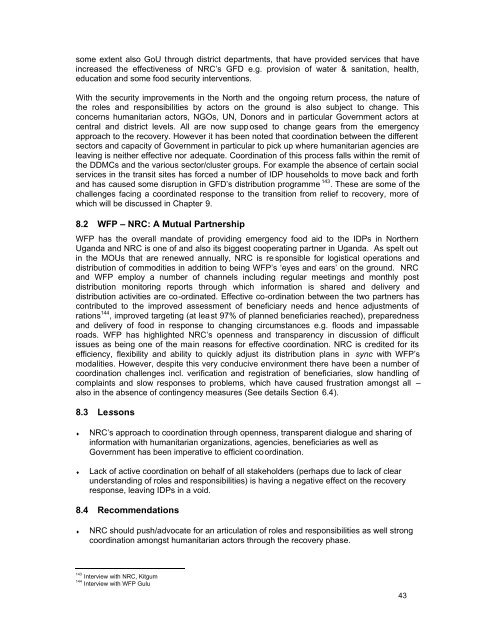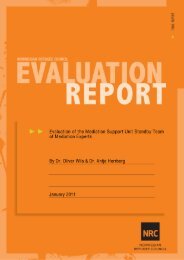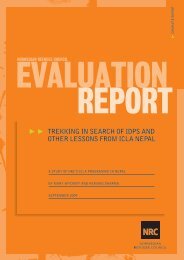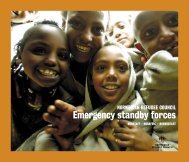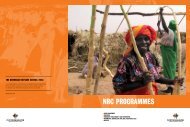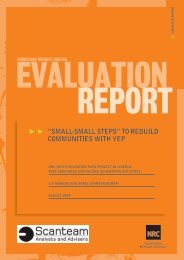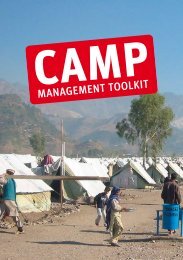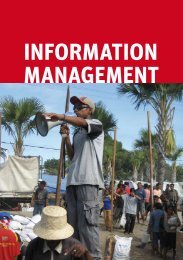evaluation of general food distribution in northern uganda: gulu ...
evaluation of general food distribution in northern uganda: gulu ...
evaluation of general food distribution in northern uganda: gulu ...
You also want an ePaper? Increase the reach of your titles
YUMPU automatically turns print PDFs into web optimized ePapers that Google loves.
some extent also GoU through district departments, that have provided services that have<strong>in</strong>creased the effectiveness <strong>of</strong> NRC’s GFD e.g. provision <strong>of</strong> water & sanitation, health,education and some <strong>food</strong> security <strong>in</strong>terventions.With the security improvements <strong>in</strong> the North and the ongo<strong>in</strong>g return process, the nature <strong>of</strong>the roles and responsibilities by actors on the ground is also subject to change. Thisconcerns humanitarian actors, NGOs, UN, Donors and <strong>in</strong> particular Government actors atcentral and district levels. All are now supp osed to change gears from the emergencyapproach to the recovery. However it has been noted that coord<strong>in</strong>ation between the differentsectors and capacity <strong>of</strong> Government <strong>in</strong> particular to pick up where humanitarian agencies areleav<strong>in</strong>g is neither effective nor adequate. Coord<strong>in</strong>ation <strong>of</strong> this process falls with<strong>in</strong> the remit <strong>of</strong>the DDMCs and the various sector/cluster groups. For example the absence <strong>of</strong> certa<strong>in</strong> socialservices <strong>in</strong> the transit sites has forced a number <strong>of</strong> IDP households to move back and forthand has caused some disruption <strong>in</strong> GFD’s <strong>distribution</strong> programme 143 . These are some <strong>of</strong> thechallenges fac<strong>in</strong>g a coord<strong>in</strong>ated response to the transition from relief to recovery, more <strong>of</strong>which will be discussed <strong>in</strong> Chapter 9.8.2 WFP – NRC: A Mutual PartnershipWFP has the overall mandate <strong>of</strong> provid<strong>in</strong>g emergency <strong>food</strong> aid to the IDPs <strong>in</strong> NorthernUganda and NRC is one <strong>of</strong> and also its biggest cooperat<strong>in</strong>g partner <strong>in</strong> Uganda. As spelt out<strong>in</strong> the MOUs that are renewed annually, NRC is re sponsible for logistical operations and<strong>distribution</strong> <strong>of</strong> commodities <strong>in</strong> addition to be<strong>in</strong>g WFP’s ‘eyes and ears’ on the ground. NRCand WFP employ a number <strong>of</strong> channels <strong>in</strong>clud<strong>in</strong>g regular meet<strong>in</strong>gs and monthly post<strong>distribution</strong> monitor<strong>in</strong>g reports through which <strong>in</strong>formation is shared and delivery and<strong>distribution</strong> activities are co-ord<strong>in</strong>ated. Effective co-ord<strong>in</strong>ation between the two partners hascontributed to the improved assessment <strong>of</strong> beneficiary needs and hence adjustments <strong>of</strong>rations 144 , improved target<strong>in</strong>g (at least 97% <strong>of</strong> planned beneficiaries reached), preparednessand delivery <strong>of</strong> <strong>food</strong> <strong>in</strong> response to chang<strong>in</strong>g circumstances e.g. floods and impassableroads. WFP has highlighted NRC’s openness and transparency <strong>in</strong> discussion <strong>of</strong> difficultissues as be<strong>in</strong>g one <strong>of</strong> the ma<strong>in</strong> reasons for effective coord<strong>in</strong>ation. NRC is credited for itsefficiency, flexibility and ability to quickly adjust its <strong>distribution</strong> plans <strong>in</strong> sync with WFP’smodalities. However, despite this very conducive environment there have been a number <strong>of</strong>coord<strong>in</strong>ation challenges <strong>in</strong>cl. verification and registration <strong>of</strong> beneficiaries, slow handl<strong>in</strong>g <strong>of</strong>compla<strong>in</strong>ts and slow responses to problems, which have caused frustration amongst all –also <strong>in</strong> the absence <strong>of</strong> cont<strong>in</strong>gency measures (See details Section 6.4).8.3 Lessons♦♦NRC’s approach to coord<strong>in</strong>ation through openness, transparent dialogue and shar<strong>in</strong>g <strong>of</strong><strong>in</strong>formation with humanitarian organizations, agencies, beneficiaries as well asGovernment has been imperative to efficient coord<strong>in</strong>ation.Lack <strong>of</strong> active coord<strong>in</strong>ation on behalf <strong>of</strong> all stakeholders (perhaps due to lack <strong>of</strong> clearunderstand<strong>in</strong>g <strong>of</strong> roles and responsibilities) is hav<strong>in</strong>g a negative effect on the recoveryresponse, leav<strong>in</strong>g IDPs <strong>in</strong> a void.8.4 Recommendations♦NRC should push/advocate for an articulation <strong>of</strong> roles and responsibilities as well strongcoord<strong>in</strong>ation amongst humanitarian actors through the recovery phase.143Interview with NRC, Kitgum144Interview with WFP Gulu43


